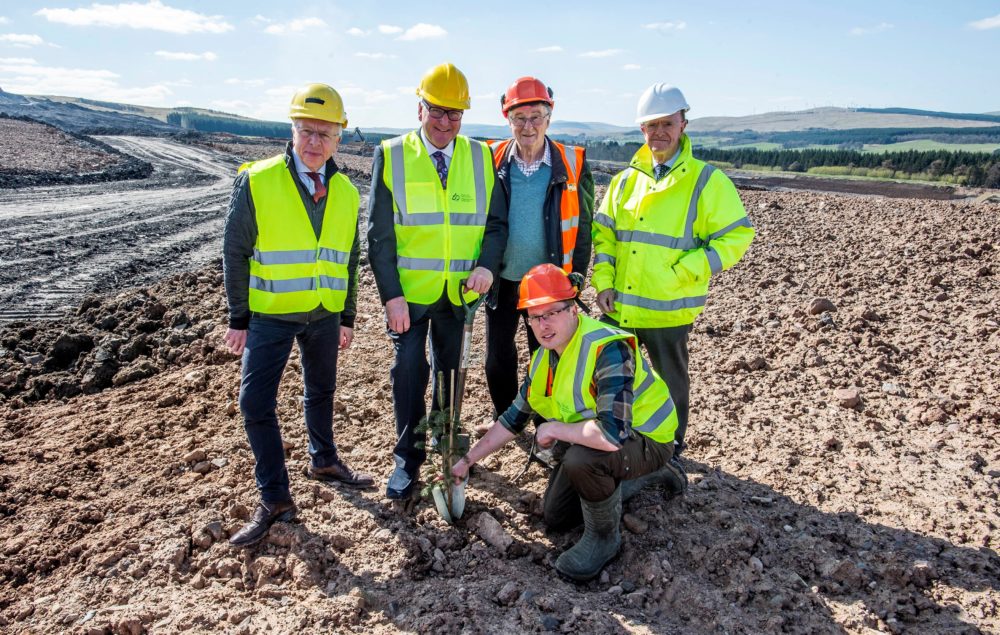A long-term project to breathe new life into former coal mining sites in the central belt of Scotland will see up to five million trees being planted, opening up new green places and revitalising communities.
The transformation of the sites will be led by new Scottish Government agency Forestry and Land Scotland (FLS), working in partnership with the Scottish Mines Restoration Trust (SMRT), Hargreaves, Hall Construction and local authorities.
As well as benefitting local people and communities, the ambitious project will contribute towards national climate change ambitions. These include targets for creating new woodlands and planting trees, locking up carbon, improving biodiversity and importantly creating vibrant greenspace for local landscapes blighted by the legacy of opencast mining.
Visiting one of the key sites earmarked for future greening at Mainshill in South Lanarkshire, Rural Economy Secretary Fergus Ewing said:
“I want to see more trees being planted across Scotland. This is a prime example of the exciting type of work that Forestry and Land Scotland can deliver for people and communities.
“I want to pay tribute to everyone involved at the Scottish Mines Restoration Trust whose tireless efforts are now coming to fruition. By working with the Trust and South Lanarkshire Council, this vacant and derelict site at Mainshill will be restored carefully to an economic use that also benefits climate change.
“But most importantly, this work will help transform and strengthen the communities that have been affected by open cast mining. With new planting and careful restoration of the sites, communities will see a total transformation, resulting in new greenspace and recreation opportunities right on their doorstep.”
The Scottish Mines Restoration Trust is currently spending around £5 million to restore the soils and create access to the Mainshill coalmine site.
Professor Russel Griggs OBE, chair of SMRT, said:
“The role of SMRT is to facilitate the restoration of abandoned opencast sites in consultation with all of the stakeholders involved in the process.
“Working with local authorities, contractors, and community organisations, we have developed a plan of action for each of the sites, and we’re progressing with activity across East Ayrshire, South Lanarkshire, and Fife.
“In our restoration planning, we are always mindful of the importance of conserving and maintaining trees and woodland, and our activity will continue to complement Scotland’s Forestry Strategy 2019 to 2029.
“Over the last four years, we’ve worked closely with South Lanarkshire Council and Forestry and Land Scotland to develop a fully-funded restoration programme for Mainshill. Activity so far is enhancing the appearance of the area and making parts of the site accessible to members of the public.”
Jim Smith, chairperson of Douglas Community Council, added:
“It’s great to see the Scottish Mines Restoration Trust, South Lanarkshire Council, Hall Construction, and Forestry and Land Scotland taking on a site that was in disrepair and bringing it back into community use.
“Mainshill lends itself to pathways and beautiful walks, and there are some fantastic viewpoints out across the area.
“We are very thankful to the organisations involved and look forward to seeing how the work continues to progress.”
Fergus Ewing (Rural Economy Secretary), Professor Russel Griggs OBE ( Chair of the Scottish Mines Restoration Trust) and Simon Hodgson (Chief Executive of Forestry and Land Scotland)
Forestry and Land Scotland is currently working with the land owners of other opencast mining sites located in South Lanarkshire, Ayrshire and in Fife. The long-term intention is to seek to agree a purchase of these opencast sites and transform them into vibrant and economically productive greenspace.
If all the sites under discussion ultimately come to fruition, and following due process, the initiative has the potential to produce 2,500 hectares of new planting, the equivalent of 2,500 football pitches or five million trees.
Main photo:
Simon Hodgson (Chief Executive of Forestry and Land Scotland), Fergus Ewing (Rural Economy Secretary), Jim Smith (Chairperson of Douglas Community Council), Professor Russel Griggs OBE ( Chair of the Scottish Mines Restoration Trust) and, kneeling, James Hand (Forestry and Land Scotland)





